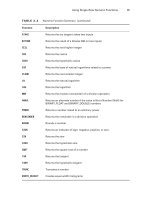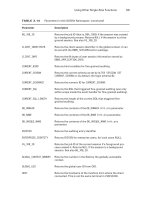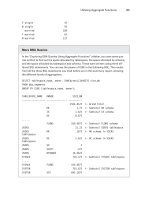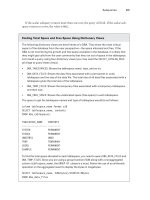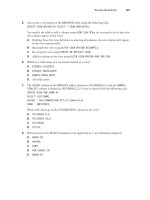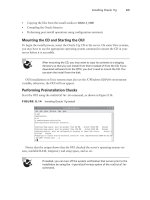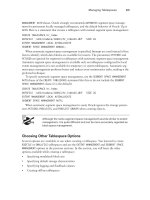Tài liệu OCA: Oracle Database 11g Administrator Certified Associate- P8 docx
Bạn đang xem bản rút gọn của tài liệu. Xem và tải ngay bản đầy đủ của tài liệu tại đây (715.81 KB, 50 trang )
Review Questions
281
13. The following table describes the DEPARTMENTS table:
Column Name
dept_id dept_name mgr_id location_id
Key Type pk
Nulls/Unique NN
FK Table
Datatype NUMBER VARCHAR2 NUMBER NUMBER
Length 4 30 6 4
Default Value None None None 99
Which of the following INSERT statements will raise an exception?
A. INSERT INTO departments (dept_id, dept_name, location_id)
VALUES(280,’Security’,1700);
B. INSERT INTO departments
VALUES(280,’Security’,1700);
C. INSERT INTO departments
VALUES(280,’Corporate Giving’,266,1700);
D. None of these statements will raise an exception.
14. Refer to the DEPARTMENTS table structure in question 13. Two SQL statements are shown
here. Choose the best option that describes the SQL statements.
1. INSERT INTO departments (dept_id, dept_name, mgr_id)
VALUES(280,’Security’,1700);
2. INSERT INTO departments (dept_id, dept_name, mgr_id, location_id)
VALUES(280,’Security’,1700, NULL);
A. Statements 1 and 2 insert the same values to all columns in the table.
B. Statements 1 and 2 insert different values to at least one column in the table.
C. The location_id column must be included in the column list of statement 1.
D. A NULL value cannot be inserted explicitly in statement 2.
95127c05.indd 281 2/17/09 12:20:00 PM
Please purchase PDF Split-Merge on www.verypdf.com to remove this watermark.
282
Review Questions
15. The SALES table contains the following data:
SELECT channel_id, COUNT(*)
FROM sales
GROUP BY channel_id;
C COUNT(*)
- ----------
T 12000
I 24000
How many rows will be inserted into the NEW_CHANNEL_SALES table with the following
SQL statement?
INSERT FIRST
WHEN channel_id =’C’ THEN
INTO catalog_sales (prod_id,time_id,promo_id
,amount_sold)
VALUES (prod_id,time_id,promo_id,amount_sold)
WHEN channel_id =’I’ THEN
INTO internet_sales (prod_id,time_id,promo_id
,amount_sold)
VALUES (prod_id,time_id,promo_id,amount_sold)
WHEN channel_id IN (‘I’,’T’) THEN
INTO new_channel_sales (prod_id,time_id,promo_id
,amount_sold)
VALUES (prod_id,time_id,promo_id,amount_sold)
SELECT channel_id,prod_id,time_id,promo_id,amount_sold
FROM sales;
A. 0
B. 12,000
C. 24,000
D. 36,000
16. How many rows will be counted in the last SQL statement that follows?
SELECT COUNT(*) FROM emp;
120 returned
INSERT INTO emp (emp_id)
VALUES (140);
SAVEPOINT emp140;
95127c05.indd 282 2/17/09 12:20:00 PM
Please purchase PDF Split-Merge on www.verypdf.com to remove this watermark.
Review Questions
283
INSERT INTO emp (emp_id)
VALUES (141);
INSERT INTO emp (emp_id)
VALUES (142);
INSERT INTO emp (emp_id)
VALUES (143);
TRUNCATE TABLE employees;
INSERT INTO emp (emp_id)
VALUES (144);
ROLLBACK;
SELECT COUNT(*) FROM emp;
A. 121
B. 0
C. 124
D. 143
17. Which is the best option that describes the following SQL statement?
1. UPDATE countries
2. CNT_NAME = UPPER(CNT_NAME)
3. WHERE country_code BETWEEN 1 and 99;
A. The statement is missing the keyword SET, but the statement will work just fine
because SET is an optional keyword.
B. The BETWEEN operator cannot be used in the WHERE clause used in an UPDATE statement.
C. The function UPPER(CNT_NAME) should be changed to UPPER(‘CNT_NAME’).
D. The statement is missing keyword SET; hence, the statement will fail.
18. The table ORDERS has 35 rows. The following UPDATE statement updates all 35 rows. Which
is the best option?
UPDATE orders
SET ship_date = TRUNC(ship_date)
WHERE ship_date != TRUNC(ship_date)
A. When all rows in a table are updated, the LOCK TABLE orders IN EXCLUSIVE MODE
statement must be executed before the UPDATE statement.
B. No other session can query from the table until the transaction ends.
C. Since all rows are updated, there is no need for any locking, and hence Oracle does not
lock the records.
D. The statement locks all the rows until the transaction ends.
95127c05.indd 283 2/17/09 12:20:00 PM
Please purchase PDF Split-Merge on www.verypdf.com to remove this watermark.
284
Review Questions
19. Which of the following INSERT statements will raise an exception?
A. INSERT INTO EMP SELECT * FROM NEW_EMP;
B. INSERT FIRST WHEN DEPT_NO IN (12,14) THEN INSERT INTO EMP SELECT * FROM
NEW_EMP;
C. INSERT FIRST WHEN DEPT_NO IN (12,14) THEN INTO EMP SELECT * FROM NEW_EMP;
D. INSERT ALL WHEN DEPT_NO IN (12,14) THEN INTO EMP SELECT * FROM NEW_EMP;
20. What will the salary of employee Arsinoe be at the completion of the following SQL
statements?
UPDATE emp
SET salary = 1000
WHERE name = ‘Arsinoe’;
SAVEPOINT Point_A;
UPDATE emp
SET salary = salary * 1.1
WHERE name = ‘Arsinoe’;
SAVEPOINT Point_B;
UPDATE emp
SET salary = salary * 1.1
WHERE name = ‘Berenike’;
SAVEPOINT point_C;
ROLLBACK TO SAVEPOINT point_b;
COMMIT;
UPDATE emp
SET salary = 1500
WHERE name = ‘Arsinoe’;
SAVEPOINT point_d;
ROLLBACK TO point_d;
COMMIT;
A. 1000
B. 1100
C. 1111
D. 1500
95127c05.indd 284 2/17/09 12:20:01 PM
Please purchase PDF Split-Merge on www.verypdf.com to remove this watermark.
Answers to Review Questions
285
Answers to Review Questions
1. D. When inserting from another table using a subquery, the VALUES clause should not be
included. Options B and C are invalid syntaxes for the INSERT statement.
2. E. If a transaction is not currently open, any INSERT, UPDATE, MERGE, DELETE, SELECT FOR
UPDATE, or LOCK statement will implicitly begin a transaction.
3. B, C. Option A will error out because when using columns in set, a subquery must be used
as in option C. Option D is wrong because AND is used instead of a comma to separate col-
umns in the SET clause.
4. A, D. COMMIT, ROLLBACK, and any DDL statement end a transaction—DDL is automatically
committed. INSERT, UPDATE, and DELETE statements require a commit or rollback.
5. A. Option A uses a correlated subquery to match the correct employee. Option B selects
all the rows in the subquery and hence will generate an error. Option C is not valid syntax.
Option D will update all the rows in the table since the UPDATE statement does not have a
WHERE clause. The WHERE clause preset belongs to the subquery.
6. B. In an UPDATE statement, the WHERE clause should come after the SET clause.
7. D. When deleting a row from a table, do not use column names. To change column values
to NULL, use the UPDATE statement.
8. C. The FROM keyword in the DELETE statement is optional. Statement 3 is first building a
subquery with the necessary condition and deleting the rows from the subquery.
9. B. When two savepoints are created with the same name, Oracle erases the older savepoint.
In the code segment, the DELETE and the first INSERT are not rolled back.
10. C. When updating more than one column in a single UPDATE statement, separate the col-
umns by a comma; do not use the AND operator.
11. D. Option A is updating the wrong table. Option B has the right syntax but will update
all the rows in the EMPLOYEE table since there is no WHERE clause for the UPDATE statement.
Since the WHERE clause is in the subquery, all the rows that do not belong to department
22 will be updated with a NULL. Options C and D are similar, except for the AND keyword
instead of WHERE.
12. D. The first INSERT statement and the last INSERT statement will be saved in the database.
The ROLLBACK TO A statement will undo the second and third inserts.
13. B. Option B will raise an exception because there are not enough column values for the
implicit column list (all columns).
14. B. Since the location_id column is defined with a default value of 99, statement 1 will
insert 99 for location_id. In statement 2, a NULL is explicitly inserted into the location_id
column; Oracle will not replace the NULL with the default value defined.
95127c05.indd 285 2/17/09 12:20:01 PM
Please purchase PDF Split-Merge on www.verypdf.com to remove this watermark.
286
Answers to Review Questions
15. B. The FIRST clause tells Oracle to execute only the first WHEN clause that evaluates to TRUE
for each row. Since no rows have a channel_id of C, no rows would be inserted into the
catalog_sales table; 24,000 rows have channel_id of I, so control would pass to the sec-
ond WHEN clause 24,000 times, and the internet_sales table would get 24,000 rows. Since
the second WHEN clause evaluates to TRUE and the INSERT FIRST option is specified, these
rows would not make it to the third WHEN clause and would not be inserted into the new_
channel_sales table. Had the INSERT ALL option been used, these 24,000 rows would
also get inserted into the new_channel_sales table; 12,000 rows have a channel_id of T,
so control would pass all the way to the third WHEN clause for these rows, and 12,000 rows
would get inserted into new_channel_sales.
16. C. The TRUNCATE statement is DDL and performs an implicit commit. After the TRUNCATE
statement on the employees table, there are 124 rows in the emp table. The one row that
got inserted was removed when the ROLLBACK statement was executed.
17. D. You must have the SET keyword in an UPDATE statement. The BETWEEN operator and any
other valid operators are allowed in the WHERE clause.
18. D. When DML operations are performed, Oracle automatically locks the rows. You can
query (read) the rows, but no other DML operation is allowed on those rows. When you read
the rows, Oracle constitutes a read-consistent view using the undo segments.
19. B. The keywords INSERT INTO are required in single-table INSERT statements but are not
valid in multiple-table INSERT statements.
20. D. The final rollback (to point_d) will roll the changes back to just after setting the salary
to 1500.
95127c05.indd 286 2/17/09 12:20:01 PM
Please purchase PDF Split-Merge on www.verypdf.com to remove this watermark.
Chapter
6
Creating Tables and
Constraints
ORACLE DATABASE 11g: SQL
FUNDAMENTALS I EXAM OBJECTIVES
COVERED IN THIS CHAPTER:
Using DDL Statements to Create and Manage Tables
Categorize the main database objects
Review the table structure
List the data types that are available for columns
Create a simple table
Explain how constraints are created at the time of table
creation
Describe how schema objects work
95127c06.indd 287 2/18/09 6:45:46 AM
Please purchase PDF Split-Merge on www.verypdf.com to remove this watermark.
An Oracle database has many different types of objects.
Related objects are logically grouped together in a schema,
which consists of various types of objects. The basic types of
objects in an Oracle Database are tables, indexes, constraints, sequences, and synonyms.
Though this chapter discusses tables and constraints, I will start the chapter with an over-
view of the main database objects in Oracle.
The table is the basic structure of data storage in Oracle. A table has columns as part of
the definition and stores rows of data. In a relational database, the data in various tables
may be related. A constraint can be considered as a rule or policy defined in the database to
enforce data integrity and business rules. In this chapter, I will discuss creating tables and
using constraints. Since the table is the most important type of object in an Oracle Data-
base, it is important to know how to create tables and constraints on tables.
Database Objects Overview
Data in the Oracle Database is stored in tables. A table is the main database object. Many
other database objects, whether or not they store data, are generally based on the tables.
Let’s review the main database objects in Oracle that are relevant for this certification exam:
Table A table is defined with columns and stores rows of data. A table should have at least
one column. In Oracle, a table normally refers to a relational table. You can also create object
tables. Object tables are created with user-defined datatypes. Temporary tables (called global
temporary tables in Oracle) are used to hold temporary data specific to a transaction or
session. A table can store a wide variety of data. Apart from storing text and numeric infor-
mation, you can store date, timestamp, binary, or raw data (such as images, documents, and
information about external files). A table can have virtual columns. As the name indicates,
these types of columns do not consume storage space on disk; the database derives values
in virtual columns from normal columns. Tables are discussed in the next sections of this
chapter.
View A view is a customized representation of data from one or more tables and/or views.
Views are used as a window to show information from tables in a certain way or to restrict
the information. Views are queries stored in the database that select data from one or more
tables. They also provide a way to restrict data from certain users, thus providing an addi-
tional level of security.
95127c06.indd 288 2/18/09 6:45:46 AM
Please purchase PDF Split-Merge on www.verypdf.com to remove this watermark.
Database Objects Overview
289
Sequence A sequence is a way to generate continuous numbers. Sequences are useful for
generating unique serial numbers or key values. The sequence definition is stored in the
data dictionary. Sequence numbers are generated independently of other database objects.
Synonym A synonym is an alias for any table, view, sequence, or other accessible database
object. Because a synonym is simply an alias, it requires no storage other than its definition
in the data dictionary. Synonyms are useful because they hide the identity of the underlying
object. The object can even be part of another database. A public synonym is accessible to
all users of the database, and a private synonym is accessible only to its owner.
Index An index is a structure associated with tables used to speed up the queries. An
index is an access path to reach the desired row faster. Oracle has B-tree and bitmap indexes.
Creating/dropping indexes does not affect the storage of data in the underlying tables. You
can create unique or nonunique indexes. Unique indexes are created automatically by Oracle
when you create a primary key or a unique key constraint in a table. A composite index has
more than one column in the index.
Views, sequences, synonyms, and indexes are discussed in Chapter 7,
“Creating Schema Objects.”
Oracle 11g has a wide array of database objects to suit various application requirements.
These objects are not discussed in this book because they are not part of the certifica-
tion exam at this time. Some of the other database objects that may be used in application
development are clusters, dimensions, directories, functions, Java sources/classes, libraries,
materialized views, and types. To learn more about the various Oracle 11g database schema
objects, please refer to the Oracle documentation called “Oracle Database Administrators
Guide 11g Release 1 (11.) Part Number B28310-04,” which is available online at
www.oracle
.com/pls/db111/db111.homepage
.
Schema Objects
A schema is a collection of related database objects grouped together. For example, a schema
can have tables, views, triggers, synonyms, and PL/SQL programs such as procedures. A
schema is owned by a database user and has the same name as the user. If the database user
does not own any database objects, then no schema is associated with the user. A schema is
a logical grouping of database objects.
A database user can have only one schema associated and is created when you create any
database object. They may include any or all the basic database objects discussed earlier.
Oracle 11g may also include the following types of structures in the schema. These objects
are listed here only to give you an overview of schemas; creating and managing these
objects are not part of the certification exam at this time. For the certification exam, prepare
to know the schema objects discussed in this chapter and in Chapter 7.
95127c06.indd 289 2/18/09 6:45:47 AM
Please purchase PDF Split-Merge on www.verypdf.com to remove this watermark.
290
Chapter 6
Creating Tables and Constraints
Materialized view Materialized views are objects used to summarize and replicate data.
They are similar to views but occupy storage space. Materialized views are mainly used in
data-warehouse environments where data needs to be aggregated and stored so that queries
and reports run faster. Materialized views can also be used to replicate data from another
database.
Dimension A dimension is a logical structure to define the relationship between columns
in a table. Dimensions are defined in the data dictionary and do not occupy any storage space.
The columns in a dimension can be from a single table or from multiple tables. An example of
a dimension would be the relationship between country, state, and city in a table that stores
address information.
Cluster A cluster is a method of storing data from related tables at a common physical
location. You can share the storage of rows in related tables for performance reasons if the
access to the rows in the tables always involves join operations on the tables. For example,
if you have an orders table and a customers table in the schema, you can query the orders
table always joining the customers table, because that’s where you get the customer name
associated with the customer ID. A cluster may be created for the orders and customers
tables so that the rows associated with the same customer are stored in the same physical
storage area (block). Database storage and blocks are discussed in Chapter 8, “Introducing
Oracle 11g Components and Architecture.”
Database links A database link is a schema object that enables you to access an object from
a different database. SQL queries can reference tables and views belonging to the remote
database by appending
@db_link_name
to the table or view. For example, to access the
CUSTOMER_ORDERS
table using a database link named
LONDON_SALES
, you would use
CUSTOMER_ORDERS@LONDON_SALES
.
Triggers A trigger is a stored PL/SQL program that gets executed when a specified condi-
tion occurs. A trigger can be defined on a table to “fire” when an insert, update, or delete
operation occurs on the table. A trigger may also be defined on the database to “fire” when
certain database conditions occur, such as starting the database, or when a database error
occurs.
Java objects Oracle Database 11g includes Java objects such as Java classes, Java sources,
and Java resources. Java stored programs can be created using the different Java object types.
PL/SQL programs PL/SQL stored programs include procedures, functions, and packages.
A procedure is a PL/SQL programmatic construct. A function is similar to a procedure but
always returns a value. A package is a grouping of related PL/SQL objects.
Built-in Datatypes
When creating tables, you must specify a datatype for each column you define. Oracle
11g is rich with various datatypes to store different kinds of information. By choosing the
95127c06.indd 290 2/18/09 6:45:47 AM
Please purchase PDF Split-Merge on www.verypdf.com to remove this watermark.
Built-in Datatypes
291
appropriate datatype, you will be able to store and retrieve data without compromising its
integrity. A datatype associates a predefined set of properties with the column.
The datatypes in Oracle 11g can be classified into five major categories. Figure 6.1 shows
the categories and the datatype names.
FIGURE 6.1 Oracle built-in datatypes
Character
CHAR
VARCHAR2
CLOB
LONG
NCHAR
NVARCHAR2
NCLOB
Numeric
NUMBER
BINARY_FLOAT
BINARY_DOUBLE
FLOAT
Binary
RAW
LONG RAW
BLOB
BFILE
Date and Time
DATE
TIMESTAMP
TIMESTAMP WITH TIME ZONE
TIMESTAMP WITH LOCAL TIME ZONE
INTERVAL YEAR TO MONTH
INTERVAL DAY TO SECOND
Row ID
ROWID
UROWID
Chapter 1, “Introducing SQL,” introduced four basic datatypes: CHAR, VARCHAR2,
NUMBER, and DATE. Here, I will review those datatypes and describe the other datatypes
that you can specify while creating a table.
Character Datatypes
Seven character datatypes can be used for defining columns in a table:
CHAR
NCHAR
VARCHAR2
NVARCHAR2
CLOB
NCLOB
LONG
95127c06.indd 291 2/18/09 6:45:47 AM
Please purchase PDF Split-Merge on www.verypdf.com to remove this watermark.
292
Chapter 6
Creating Tables and Constraints
Character datatypes store alphanumeric data in the database character set or in the
Unicode character set. You define the database character set when you create the database.
The character set determines which languages can be represented in the database. For
example, US7ASCII is a 7-bit ASCII character set that can represent the English language
and any other language that uses the English alphabet set. WE8ISO8859P1 is an 8-bit
character set that can support multiple European languages such as English, German, French,
Albanian, Spanish, Portuguese, Irish, and so on, because they all use a similar writing script.
Unicode, the Universal Character Set, allows you to store any language character using a
single character set. The Unicode character set supported by Oracle is either 16-bit encod-
ing (UTF-16) or 8-bit encoding (UTF-8). You can choose the Unicode datatypes to be used
in the database while creating the database. The default is the AL16UTF16 character set,
which is UTF-16 encoding.
CHAR
The syntax for the CHAR datatype is as follows:
CHAR [(<size> [BYTE | CHAR ] ) ]
The CHAR datatype is fixed-length, with the maximum size of the column specified in
parentheses. You can also include the optional keyword
BYTE
or
CHAR
inside the parentheses
along with the size to indicate whether the size is in bytes or in characters.
BYTE
is the default.
For single-byte-database character sets (such as US7ASCII), the size specified in bytes
and the size specified in characters are the same. If the column value is shorter than the size
defined, trailing spaces are added to the column value. Specifying the size is optional, and
the default size is 1 byte. The maximum allowed size in a CHAR datatype column is 2,000
bytes. Here are few examples of specifying a CHAR datatype column:
employee_id CHAR (5)
employee_name CHAR (100 CHAR)
employee_sex CHAR
NCHAR
The syntax for the NCHAR datatype is as follows:
NCHAR [ ( <size> ) ]
The NCHAR datatype is similar to CHAR, but it is used to store Unicode character-set
data. The NCHAR datatype is fixed-length, with a maximum size of 2,000 bytes and a
default size of a character.
The size in the NCHAR datatype definition is always specified in characters. Trailing
spaces are added if the value inserted into the column is shorter than the column’s maxi-
mum length. Here is an example of specifying an NCHAR datatype column:
emp_name NCHAR (100)
95127c06.indd 292 2/18/09 6:45:47 AM
Please purchase PDF Split-Merge on www.verypdf.com to remove this watermark.
Built-in Datatypes
293
Several built-in Oracle 11g functions have options to represent NCHAR data. An
NCHAR string may be represented by prefixing the string with
N
, as in this example:
SELECT emp_name FROM employee_records
WHERE emp_name = N’John Smith’;
VARCHAR2 or VARCHAR
The syntax for the VARCHAR2 datatype is as follows:
VARCHAR2 (<size> [BYTE | CHAR] )
VARCHAR2 and VARCHAR are synonymous datatypes. VARCHAR2 specifies vari-
able-length character data. A maximum size for the column should be defined; Oracle 11g
will not assume any default value. Unlike CHAR columns, VARCHAR2 columns are not
blank-padded with trailing spaces if the column value is shorter than its maximum specified
length. You can specify the size in bytes or characters; by default, the size is in bytes. The
range of values allowed for size is from 1 to 4,000 bytes. For storing variable-length data,
Oracle recommends using VARCHAR2 rather than VARCHAR, because the behavior of
the VARCHAR datatype may change in a future release.
NVARCHAR2
The syntax for the NVARCHAR2 datatype is as follows:
NVARCHAR2 (<size>)
The NVARCHAR2 datatype is used to store Unicode variable-length data. The size is
specified in characters, and the maximum size allowed is 4,000 bytes.
If you try to insert a value into a character datatype column that is larger
than its maximum specified size, Oracle will return an error. Oracle will not
chop or truncate the inserted value to store it in the database column.
CLOB
The syntax for the CLOB datatype is as follows:
CLOB
CLOB is one of the Large Object datatypes provided to store variable-length character
data. The maximum amount of data you can store in a CLOB column is based on the block
size of the database. CLOB can store up to (4GB–1)*(database block size). You do not spec-
ify the size with this datatype definition.
NCLOB
The syntax for the NCLOB datatype is as follows:
NCLOB
95127c06.indd 293 2/18/09 6:45:47 AM
Please purchase PDF Split-Merge on www.verypdf.com to remove this watermark.
294
Chapter 6
Creating Tables and Constraints
NCLOB is one of the Large Object datatypes and stores variable-length Unicode charac-
ter data. The maximum amount of data you can store in a NCLOB column is (4GB–1)*
(database block size). You do not specify the size with this datatype definition.
LONG
The syntax for the LONG datatype is as follows:
LONG
Using the LONG datatype is discouraged in Oracle Database 11g. It is provided only for
backward compatibility. You should use the CLOB datatype instead of LONG. LONG col-
umns can store up to 2GB of character data. There can be only one LONG column in the
table definition. A LONG datatype column can be used in the
SELECT
clause of a query, the
SET
clause of the
UPDATE
statement, and the
VALUES
clause of the
INSERT
statement. You can
also create a
NOT NULL
constraint on a LONG column.
LONG datatype columns cannot appear in the following:
The
WHERE
,
GROUP BY
, or
ORDER BY
clauses
A
SELECT
clause if the
DISTINCT
operator is used
A
SELECT
list of subqueries used in
INSERT
statements
A
SELECT
list of subqueries used with the
UNION
,
INTERSECT
, or
MINUS
operator
A
SELECT
list of queries with the
GROUP BY
clause
Numeric Datatypes
Four built-in numeric datatypes can be used for defining numeric columns in a table:
NUMBER
BINARY_FLOAT
BINARY_DOUBLE
FLOAT
Numeric datatypes are used to store integer and floating-point numbers. The NUMBER
datatype can store all types of numeric data, but BINARY_FLOAT and BINARY_DOUBLE
give better performance with floating-point numbers. FLOAT is a subtype of NUMBER.
NUMBER
The syntax for the NUMBER datatype is as follows:
NUMBER [ (<precisio n> [, <scale>] )]
You can represent all non-Oracle numeric datatypes such as float, integer, decimal,
double, and so on, using the NUMBER datatype. The NUMBER datatype can store both
fixed-point and floating-point numbers. Oracle 11g introduced two new datatypes to sup-
port floating-point numbers—specifically, BINARY_FLOAT and BINARY_DOUBLE.
95127c06.indd 294 2/18/09 6:45:48 AM
Please purchase PDF Split-Merge on www.verypdf.com to remove this watermark.
Built-in Datatypes
295
BINARY_FLOAT
The syntax for the BINARY_FLOAT datatype is as follows:
BINARY_FLOAT
The BINARY_FLOAT datatype represents a 32-bit floating-point number. There is
no precision defined in the definition of this datatype because it uses binary precision.
BINARY_FLOAT uses 5 bytes for storage.
A floating-point number can have a decimal point anywhere or can have no decimal point.
Oracle stores NUMBER datatype values using decimal precision, whereas floating-point
numbers (BINARY_FLOAT and BINARY_DOUBLE) are stored using binary precision.
Oracle has three special values that can be used with floating-point numbers:
INF
: Positive infinity
-INF
: Negative infinity
NaN
: Not a Number (NaN is not the same as
NULL
)
BINARY_DOUBLE
The syntax for the BINARY_DOUBLE datatype is as follows:
BINARY_DOUBLE
The BINARY_DOUBLE datatype represents a 64-bit floating-point number. BINARY_
DOUBLE uses 9 bytes for storage. All the characteristics of BINARY_FLOAT are appli-
cable to BINARY_DOUBLE.
FLOAT
The syntax for the FLOAT datatype is as follows:
FLOAT [(precision)]
The FLOAT datatype is a subtype of NUMBER and is internally represented as NUMBER.
There is no scale for FLOAT numbers; only precision can be optionally included. The precision
can range from 1 to default binary digits. In the NUMBER datatype the precision and scale
are represented in decimal digits, whereas in FLOAT the precision is represented in binary
digits. In Oracle 11g it is recommended you use BINARY_FLOAT or BINARY_DOUBLE
instead of the FLOAT datatype.
Date and Time Datatypes
In pre–Oracle9i databases, the only datetime datatype available was DATE, which stores
the date and time. Oracle9i Database introduced the TIMESTAMP and INTERVAL data-
types to enhance the storage and manipulation of date and time data. Six datetime datatypes
in Oracle 11g can be used for defining columns in a table:
DATE
TIMESTAMP
TIMESTAMP WITH TIME ZONE
95127c06.indd 295 2/18/09 6:45:48 AM
Please purchase PDF Split-Merge on www.verypdf.com to remove this watermark.
296
Chapter 6
Creating Tables and Constraints
TIMESTAMP WITH LOCAL TIME ZONE
INTERVAL YEAR TO MONTH
INTERVAL DAY TO SECOND
The interval datatypes are used to represent a measure of time. They store the number
of months or number of days/hours between two time points. All interval components are
integers except the seconds, which may have fractional seconds represented.
DATE
The syntax for the DATE datatype is as follows:
DATE
The DATE datatype stores date and time information. You can store the dates from
January 1, 4712 BC to December 31, 9999 AD. If you specify a date value without the
time component, the default time is 12 a.m. (midnight, 00:00:00 hours). If you specify
a date value without the date component, the default value is the first day of the current
month. The DATE datatype stores century, year, month, date, hour, minute, and seconds
internally. You can display the dates in various formats using the
NLS_DATE_FORMAT
param-
eter or by specifying a format mask with the
TO_CHAR
function. The various date-format
masks are discussed in Chapter 2, “Using Single-Row Functions.”
TIMESTAMP
The syntax for
TIMESTAMP
datatype is as follows:
TIMESTAMP [(<precisio n>)]
The TIMESTAMP datatype stores date and time information with fractional seconds
precision. The only difference between the DATE and TIMESTAMP datatypes is the abil-
ity to store fractional seconds up to a precision of nine digits. The default precision is 6 and
can range from 0 to 9.
TIMESTAMP WITH TIME ZONE
The syntax for the TIMESTAMP WITH TIME ZONE datatype is as follows:
TIMESTAMP [(<precisio n>)] WITH TIME ZONE
The TIMESTAMP WITH TIME ZONE datatype is similar to the TIMESTAMP data-
type, but it stores the time-zone displacement. Displacement is the difference between the
local time and the Coordinated Universal Time (UTC, also known as Greenwich mean
time). The displacement is represented in hours and minutes. Two TIMESTAMP WITH
TIME ZONE values are considered identical if they represent the same time in UTC. For
example, 5 p.m. CST is equal to 6 p.m. EST or 3 p.m. PST.
TIMESTAMP WITH LOCAL TIME ZONE
The syntax for the TIMESTAMP WITH LOCAL TIME ZONE datatype is as follows:
TIMESTAMP [(<precisio n>)] WITH LOCAL TIME ZONE
95127c06.indd 296 2/18/09 6:45:48 AM
Please purchase PDF Split-Merge on www.verypdf.com to remove this watermark.
Built-in Datatypes
297
The TIMESTAMP WITH LOCAL TIME ZONE datatype is similar to the TIME-
STAMP datatype, but like the TIMESTAMP WITH TIME ZONE datatype, it also
includes the time-zone displacement. TIMESTAMP WITH LOCAL TIME ZONE does not
store the displacement information in the database but stores the time as a normalized form
of the database time zone. The data is always stored in the database time zone, but when
the user retrieves data, it is shown in the user’s local-session time zone.
The following example demonstrates how the DATE, TIMESTAMP, TIMESTAMP
WITH TIME ZONE, and TIMESTAMP WITH LOCAL TIME ZONE datatypes store
data. The
NLS_xx_FORMAT
parameter is explicitly set to display the values in the nondefault
format. The data is inserted at Central Daylight Time (CDT), which is seven hours behind
UTC. (The output shown in the example was reformatted for better readability.)
CREATE TABLE date_time_demo (
r_no NUMBER (2),
c_date DATE DEFAULT SYSDATE,
c_timezone TIMESTAMP DEFAULT SYSTIMESTAMP,
c_timezone2 TIMESTAMP (2) DEFAULT SYSTIMESTAMP,
c_ts_wtz TIMESTAMP (0) WITH TIME ZONE
DEFAULT SYSTIMESTAMP,
c_ts_wltz TIMESTAMP (9) WITH LOCAL TIME ZONE
DEFAULT SYSTIMESTAMP);
Table created.
INSERT INTO date_time_demo (r_no) VALUES (1);
1 row created.
ALTER SESSION SET NLS_DATE_FORMAT = ‘YYYY-MM-DD HH24:MI:SS’;
Session altered.
ALTER SESSION SET NLS_TIMESTAMP_FORMAT = ‘YYYY-MM-DD HH24:MI:SS.FF’;
Session altered.
ALTER SESSION SET NLS_TIMESTAMP_TZ_FORMAT = ‘YYYY-MM-DD HH24:MI:SS.FFTZH:TZM’;
Session altered.
SELECT * FROM date_time_demo;
R_NO C_DATE C_TIMEZONE
--------------------- ---------------------------
1 2008-10-24 13:09:14 2008-10-24 13:09:14. 000001
95127c06.indd 297 2/18/09 6:45:48 AM
Please purchase PDF Split-Merge on www.verypdf.com to remove this watermark.
298
Chapter 6
Creating Tables and Constraints
C_TIMEZONE2 C_TS_WTZ
---------------------- --------------------------
2008-10-24 13:09:14.00 2008-10-24 13:09:14.-07:00
C_TS_WLTZ
-----------------------------
2008-10-24 13:09:14.000001000
INTERVAL YEAR TO MONTH
The syntax for the INTERVAL YEAR TO MONTH datatype is as follows:
INTERVAL YEAR [(precisio n)] TO MONTH
The INTERVAL YEAR TO MONTH datatype is used to represent a period of time as
years and months.
precisio n
specifies the precision needed for the year field, and its default
is 2. Valid precision values are from 0 to 9. This datatype can be used to store the difference
between two datetime values, where the only significant portions are the year and month.
INTERVAL DAY TO SECOND
The syntax for the INTERVAL DAY TO SECOND datatype is as follows:
INTERVAL DAY [(precisio n)] TO SECOND
The INTERVAL DAY TO SECOND datatype is used to represent a period of time as
days, hours, minutes, and seconds.
precisio n
specifies the precision needed for the day
field, and its default is 6. Valid precision values are from 0 to 9. Larger precision values
allow a greater difference between the dates; for example, a precision of 2 allows values
from 0 through 99, and a precision of 4 allows values from 0 through 9999. This datatype
can be used to store the difference between two datetime values, including seconds.
The following example demonstrates the INTERVAL datatypes. It creates a table with
the INTERVAL datatypes, inserts data to it, and selects data from the table.
CREATE TABLE interval_demo (
ts1 TIMESTAMP (2),
iy2m INTERVAL YEAR (3) TO MONTH,
id2s INTERVAL DAY (4) TO SECOND);
Table created.
INSERT INTO interval_demo VALUES (
TO_TIMESTAMP(‘080101-102030.45’, ‘YYMMDD-HH24MISS.FF’),
TO_YMINTERVAL(‘3-7’),
TO_DSINTERVAL(‘4 02:20:30.30’));
1 row created.
95127c06.indd 298 2/18/09 6:45:48 AM
Please purchase PDF Split-Merge on www.verypdf.com to remove this watermark.
Built-in Datatypes
299
SELECT * FROM interval_demo;
TS1 IY2M ID2S
------------------------- -------- ---------------------
2008-01-01 10:20:30.45 +003-07 +0004 02:20:30.300000
Date Arithmetic
Datetime datatypes can be used in expressions with the
+
or
-
operator. You can use the
+
,
-
,
*
, and
/
operators with the INTERVAL datatypes. Dates are stored in the database as
Julian numbers with a fraction component for the time. A Julian date refers to the number
of days since January 1, 4712 BC. Because of the time component of the date, comparing
dates can result in fractional differences, even though the date is the same. Oracle provides
a number of functions, such as
TRUNC
, that help you remove the time component when you
want to compare only the date portions.
Adding 1 to the date simply moves the date ahead one day. You can add time to the date
by adding a fraction of a day. One day equals 24 hours, or 24 × 60 minutes, or 24 × 60 × 60
seconds. Table 6.1 shows the numbers used to add or subtract time for a datetime datatype.
TABLE 6.1 Date Arithmetic
Time to Add or Subtract Fraction Date Difference
1 day 1 1
1 hour 1/24 1/24
1 minute 1/(24×60) 1/1440
1 second 1/(24×60×60) 1/86400
Subtracting two dates gives you the difference between the dates in days. This usually
results in a fractional component that represents the time difference. If the time compo-
nents are the same, there will be no fractional results.
A datetime value operation using a numeric value results in a datetime value. The fol-
lowing example adds 2 days and 12 hours to a date value:
ALTER SESSION SET NLS_DATE_FORMAT = ‘YYYY-MM-DD HH24:MI:SS’;
SELECT TO_DATE(‘2008-10-24 13:09:14’) + 2.5 EXAMP
FROM dual;
EXAMP
-------------------
2008-10-27 01:09:14
95127c06.indd 299 2/18/09 6:45:48 AM
Please purchase PDF Split-Merge on www.verypdf.com to remove this watermark.
300
Chapter 6
Creating Tables and Constraints
This example subtracts six hours from a timestamp value:
SELECT TO_TIMESTAMP(‘2008-10-24 13:09:14.05’) - 0.25 EXAMP
FROM dual;
EXAMP
-------------------
2008-10-24 07:09:14
A datetime value subtracted from another datetime value results in a numeric value (the
difference in days). You cannot add two datetime values. Here is an example that results in
the difference between dates as a fraction of a day:
SELECT SYSDATE,
SYSDATE - TO_DATE(‘2007-10-24 13:09:14’)
FROM dual;
SYSDATE SYSDATE-TO_DATE(‘2007-10-2413:09:14’)
------------------- -------------------------------------
2008-05-11 23:34:06 200.433935
This example converts the fraction of days to hours, minutes, and seconds using the
NUMTODSINTERVAL
function:
SELECT SYSDATE,
NUMTODSINTERVAL(SYSDATE - TO_DATE(‘2008-10-24 13:09:14’), ‘DAY’)
FROM DUAL;
SYSDATE NUMTODSINTERVAL(SYSDATE
-------------------- -----------------------------
2008-10-24 15:53:04 +000000000 02:43:49.999999999
A datetime value operation using an interval value results in a datetime value. The fol-
lowing example adds one year and three months to today’s date:
SELECT TRUNC(SYSDATE),
TRUNC(SYSDATE)+TO_YMINTERVAL(‘1-3’)
FROM dual;
TRUNC(SYSDATE) TRUNC(SYSDATE)+TO_Y
------------------- -------------------
2008-10-24 00:00:00 2009-01-24 00:00:00
An interval datatype operation on another interval or numeric value results in an inter-
val value. You can use
+
and
–
between two interval datatypes and use
*
and
/
between
interval and numeric values. The following example converts a string (which represents
95127c06.indd 300 2/18/09 6:45:48 AM
Please purchase PDF Split-Merge on www.verypdf.com to remove this watermark.
